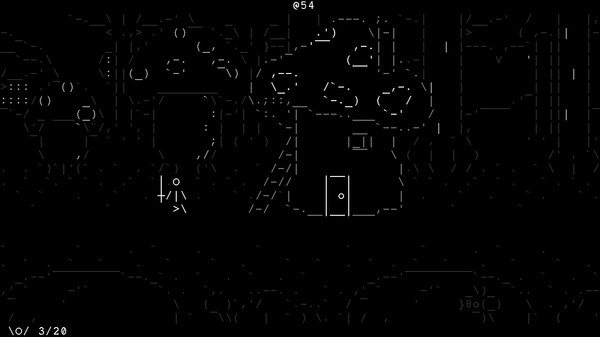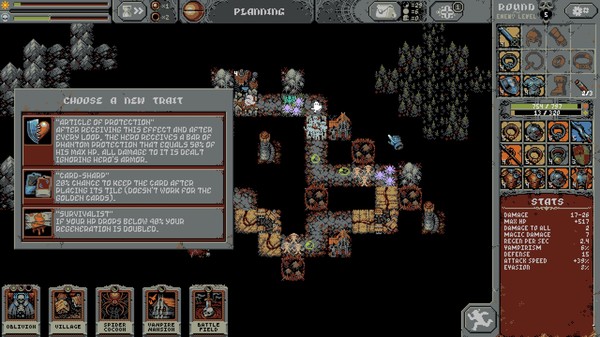Ed Note: We received a review copy of Loop Hero prior to release. The only condition we were given was not to release the review until after the embargo for the game.
So I mentioned a while back that I was gonna try to get a copy of Loop Hero to review. And to my surprise, the whole thing actually sorta worked. I’ve been playing it for just under about two weeks at this point. And right now I wouldn’t recommend it.
That probably sounds kind of strange, so let me give a little bit of context here: I’ve played about 30 hours of Loop Hero. After about hour 25, I said “Fuck It” and modified a few configuration files to give myself effectively infinite resources, bought out the rest of the tech tree, and went back to playing the game.
So when I say I wouldn’t recommend Loop Hero, it’s not that I haven’t had a good time with various parts of the game. The opening few hours from the demo were very good, enough to make me want to get the game. The last few hours after cheated to unlock everything were also much better.
The middle 25 hours were one of the most painful, grindy slogs I’ve ever tried to push through, and I ultimately gave up, and cheated. I would not have even tried to power through them if I hadn’t been given a review copy, and felt like in order to actually write a review, I needed to see the entire game. I would have just uninstalled the game, and called it a day.
So let’s talk about the game’s mechanics a bit, in order to explain why I struggled to enjoy myself.
I’ve seen Loop Hero described a lot of different ways, including: idle game, auto-battler, and rougelite. I’m not sure any of these labels quite sticks for me, but it is a game where combat happens automatically, and you as the player don’t have any input over what your character actually does.
What Loop Hero does give you input on is the items your character wears, and the the world they travel through.
As the name might suggest, a Loop Hero run consists of, well…. loops. Each run starts with a blank world map, as pictured below.

And as a run proceeds, you’ll get two types of drops from enemies. Gear, which works exactly how you think it would, and cards.
We’ll quickly talk about gear first. Characters have a limited number of gear slots, and the three classes each use slightly different types of gear, with a few things in common. This doesn’t actually matter, because once a run starts you’ll only get gear that you can equip.
All in all, there isn’t anything in the gear that feels super special or innovative. It isn’t bad, by any sense, it’s just nothing that you haven’t seen if you’ve played an ARPG before. Vamp, attack speed, crit chance, crit damage, etc. Higher rarity gear has additional stat rolls, again, much like a traditional ARPG. Unlike a traditional ARPG, once you put a piece of gear on, you cannot take it off, and any new piece of gear replaces it.
One of my few minor gripes with the game has to do with the fact that the UI display for gear isn’t fantastic, and it isn’t additive. This is fairly minor though, and not actually a big deal.
My second gripe with gear is that as far as I can tell, it’s completely random. I couldn’t find a way to influence the rolls that I got, and as such, it turns into a crap shoot. You either get gear with stats you want, or you don’t. A string of bad luck early can absolutely ruin a run, even if you make all the right decisions, and it’s one of the things that makes the game feel like less of a rougelite to me. So since you can’t influence gear, the extent to which you can do anything with it is just making quick judgement calls on if you should swap your current gear for something new.
So let’s talk about the part of the game you have a bit more influence on: the cards that make up the map.
Cards are (mostly) all from a pool that you choose beforehand. This is the deckbuilding aspect of the game.

Of the different categories, you’re required to have at least a certain amount of cards selected. And while this is purely a guess from my side, it at least feels like the cards have different drop rates.
Individual cards have rules about their placement and effects. I want to look at two cards, the Mountain and the Grove, as examples.

The Mountain is a fairly straightforward card. The more you play of them, the more HP your hero gets. One thing the mountain also does that the game does not tell you, is that after you play 10 mountains or rocks, it will spawn in a goblin camp at a random location near the road. So, after you’ve played 9 mountains, you may want to reconsider playing a 10th unless you want to add another problem to the map for yourself. In addition, you can only play the mountain on spaces at least two places away from the road.

The Grove is even simpler. Every 2 in-game days that pass, the Grove will spawn a Ratwolf enemy, which will either stay on its current tile, or move left or right. It can only be placed on the road.
Now how do these cards interact with each other?
Well, uh. Actually, they don’t.
In fact, a surprising number of the cards in the game don’t interact with each other, or at least don’t interact in interesting ways. And this brings me to my first big problem with the game: Basic Terrain Tile configuration isn’t actually all that interesting or exciting. At the same time, it’s what you’ll be spending a majority of a run doing.
The game has about 26 cards to build your deck , and almost none of them interact with each other in particularly interesting ways. In fact, only one of them really has a large number of interesting interactions: the River card. It’s also one of the very last things you’ll get access to.
And I think this is my primary problem with the game: the “Loop” of Loop Hero isn’t one of interesting runs, where you have to solve tile placement puzzles. It’s a game of perpetual grind, where you make tiny amounts of incremental progress via upgrades, gear and other small stuff, while hoping this is the run where you get the gear you need to kill the boss.
I have some other gripes with the game as well, but they’re ultimately much smaller things, and changing them wouldn’t change how I feel about the game.
There are a lot of good things about Loop Hero. The art is gorgeous, the game has a bunch of text display options, including a dyslexic setting, and the soundtrack is solid.
The core gameplay, though, of a roguelike auto-battler never really clicked for me. The game felt far more like an idle game by the very end. And that’s not what I was hoping for from the demo. I was hoping for a different type of roguelite, one where you build the world instead of just fight it, a game where learning about the interplay of mechanics, and not just farming and numbers was the key to success. And while Loop Hero might be one of the more complex idle games out there, it’s not quite the roguelite I was hoping for.
Loop Hero is available here on Steam. I should mention that at time of writing, the game has been rated “Overwhelmingly Positive” by other people who’ve played it. So I may just be the odd-man out here. But right now, unless you’re looking for an idle game, I wouldn’t recommend it.




















